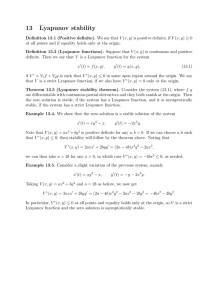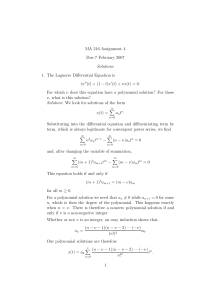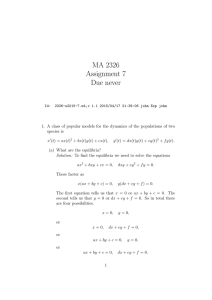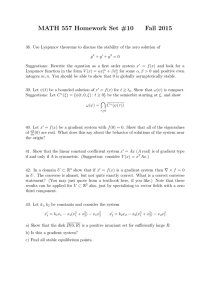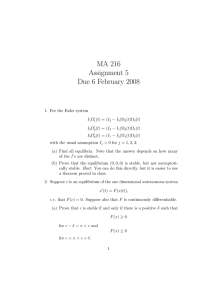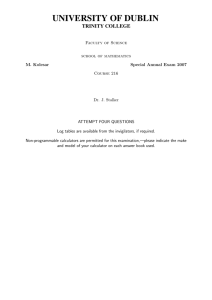Topic #22 16.30/31 Feedback Control Systems • Lyapunov Stability Analysis
advertisement
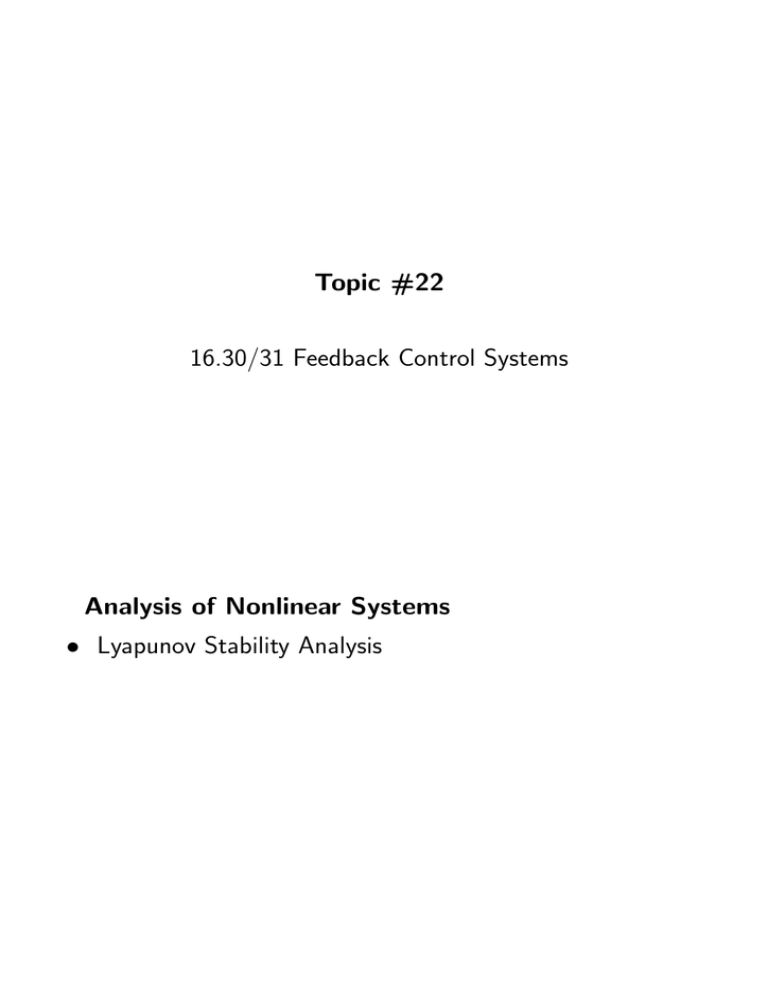
Topic #22
16.30/31 Feedback Control Systems
Analysis of Nonlinear Systems
• Lyapunov Stability Analysis
Fall 2010
16.30/31 22–2
Lyapunov Stability Analysis
• Very general method to prove (or disprove) stability of nonlinear sys­
tems.
• Formalizes idea that all systems will tend to a “minimum-energy”
state.
• Lyapunov’s stability theory is the single most powerful method
in stability analysis of nonlinear systems.
• Consider a nonlinear system ẋ = f (x)
• A point x0 is an equilibrium point if f (x0) = 0
• Can always assume x0 = 0
• In general, an equilibrium point is said to be
• Stable in the sense of Lyapunov if (arbitrarily) small devia­
tions from the equilibrium result in trajectories that stay (arbitrar­
ily) close to the equilibrium for all time.
• Asymptotically stable if small deviations from the equilibrium
are eventually “forgotten,” and the system returns asymptotically
to the equilibrium point.
• Exponentially stable if it is asymptotically stable, and the con­
vergence to the equilibrium point is “fast.”
November 27, 2010
Fall 2010
16.30/31 22–3
Stability
• Let x = 0 ∈ D be an equilibrium point of the system
ẋ = f (x),
where f : D → Rn is locally Lipschitz in D ⊂ R
• f (x) is locally Lipschitz in D if ∀x ∈ D ∃I(x) such that |f (y) −
f (z)| ≤ L|y − z| for all y, z ∈ I(x).
• Smoothness condition for functions which is stronger than regular
continuity – intuitively, a Lipschitz continuous function is limited
in how fast it can change. (see here)
• A sufficient condition for a function to be Lipschitz is that the
Jacobian ∂f /∂x is uniformly bounded for all x.
• The equilibrium point is
• Stable in the sense of Lyapunov (ISL) if, for each ε ≥ 0,
there is δ = δ(ε) > 0 such that
�x(0)� < δ ⇒ �x(t)� ≤ ε,
∀t ≥ 0;
• Asymptotically stable if stable, and there exists δ > 0 s.t.
�x(0)� < δ ⇒ lim x(t) = 0
t→+∞
• Exponentially stable if there exist δ, α, β > 0 s.t.
�x(0)� < δ ⇒ �x(t)� < βe−αt, ∀t ≥ 0;
• Unstable if not stable.
ISL or Marginally Stable
xe
x(0)
Unstable
November 27, 2010
δ
�
Fall 2010
16.30/31 22–4
• How do we analyze the stability of an equilibrium point?
• Already talked about how to linearize the dynamics about the equilib­
rium point and use the conclusion from the linear analysis to develop
a local conclusion
• Often called Lyapunov’s first method
• How about a more global conclusion?
• Powerful method based on concept of Lyapunov function
�
Lyapunov’s second method
• LF is a scalar function of the state that is always non-negative,
is zero only at the equilibrium point, and is such that its value is
non-increasing along system’s trajectories.
• Generalization of result from classical mechanics, which is that a vi­
bratory system is stable if the total energy is continually decreasing.
November 27, 2010
Fall 2010
16.30/31 22–5
Lyapunov Stability Theorem
• Let D be a compact subset1 of the state space, containing the equi­
librium point (i.e., {x0} ⊂ D ⊂ Rn), and a let there be a function
V : D → R.
• Theorem: The equilibrium point x0 is stable (in the sense of Lya­
punov) if the V satisfies the following conditions (and if it does, it is
called a Lyapunov function):
1.V (x) ≥ 0, for all x ∈ D.
2.V (x) = 0 if and only if x = x0.
3. For all x(t) ∈ D,
V̇ (x(t)) ≡
d
∂V (x) dx(t)
·
V (x(t)) =
dt
∂x
dt
∂V (x)
· f (x) ≤ 0
=
∂x
• Furthermore,
1. If V̇ (x(t)) = 0 only when x(t) = x0, then the equilibrium is
asymptotically stable.
2. If V̇ (x(t)) < −αV (x(t)), for some α > 0, then the equilibrium
is exponentially stable.
• Finally, to ensure global stability, need to impose extra condition
that as �x� → +∞, then V (x) → +∞.
•Such a function V is said radially unbounded
1A
compact set is a set that is closed and bounded, e.g., the set {(x, y) : 0 ≤ x ≤ 1, −x2 ≤ y ≤ x2 .
November 27, 2010
Fall 2010
16.30/31 22–6
• Note that condition (1) in the Theorem corresponds to V (x) being
positive definite (V (x) > 0 for all x �= 0 and V (0) = 0.)
V (x) being positive semi-definite means V (x) ≥ 0 for all x, but
V (x) can be zero at points other than x = 0.)
i) V (x) = x21 + x22
PD, PSD, ND, NSD, ID
ia) V (x) = x21
PD, PSD, ND, NSD, ID
ii) V (x) = (x1 + x2)2
PD, PSD, ND, NSD, ID
iii) V (x) = −x21 − (3x1 + 2x2)2
PD, PSD, ND, NSD, ID
iv) V (x) = x1x2 + x22
PD, PSD, ND, NSD, ID
2x2
v)V (x) = x21 + 1+x22
2
November 27, 2010
PD, PSD, ND, NSD, ID
Fall 2010
16.30/31 22–7
Example 1: Pendulum
• Typical method for finding candidate Lyapunov functions is based on
the mechanical energy in the system
• Consider a pendulum:
g
˙
θ¨ = − sin(θ) − cθ,
l
• Setting x1 = θ, x2 = θ̇:
ẋ1 = x2
g
ẋ2 = − sin(x1) − cx2
l
• Can use the mechanical energy as a Lyapunov function candidate:
1
V = ml2x22 + mgl(1 − cos(x1))
2
• Analysis:
V (0) = 0
V (x1, x2) ≥ 0
V̇ (x1, x2) = (ml2x2)ẋ2 + mgl sin(x1)ẋ1
= −cml2x22 ≤ 0
• Thus the equilibrium point (x1, x2) = 0 is stable in the sense of
Lyapunov.
• But note that V̇ is only NSD
November 27, 2010
Fall 2010
16.30/31 22–8
Example 2: Linear System
• Consider a system ẋ = Ax.
• Another common choice: quadratic Lyapunov functions,
V (x) = �M x�2 = xT M T M x = xT P x
with P = M T M , a symmetric and positive definite matrix.
• Easy to check that V (0) = 0, and V (x) ≥ 0
• To find the derivative along trajectories, note that
V̇ (x) = ẋT P x + xT P ẋ
= xT AT P x + xT P Ax
= xT (AT P + P A)x
• Next step: make this derivative equal to a given negative-definite
function
V̇ (x) = xT (AT P + P A)x = −xT Qx,
(Q > 0)
• Then appropriate matrix P can be found by solving:
AT P + P A = −Q
• Not surprisingly, this is called a Lyapunov equation
• Note that it happens to be the linear part of a Riccati equation
• It always has a solution if all the eigenvalues of A are in the left
half plane (i.e., A is Hurwitz, and defines a stable linear system)
November 27, 2010
Fall 2010
16.30/31 22–9
Example 3: Controlled Linear System
• Consider a possibly unstable, but controllable linear system
ẋ = Ax + Bu
• We know that if we solve the Riccati equation
AT P + P A − P BR−1B T P + Q = 0
and set u = Kx with K = −R−1B T P , the closed-loop system is
stable.
ẋ = (A + BK)x
• Can confirm this fact using the Lyapunov Thm.
• In particular, note that the solution P of the Riccati equation has the
interpretation of a Lyapunov function, i.e., for this closed-loop system
we can use
V (x) = xT P x
• Check:
V̇ (x) =
=
=
=
=
November 27, 2010
xT P ẋ + ẋT P x
xT P (A + BK)x + xT (A + BK)T P x
xT (P A + P BK + AT P + K T B T P )x
xT (AT P + P A − P BR−1B T P − P BR−1B T P )x
−xT (Q + P BR−1B T P )x ≤ 0
Fall 2010
16.30/31 22–10
Example 4: Local Region
• Consider the system
dx
2
=
− x
dt
1+x
which has equilibrium points at x = 1 and x = −2.
• Around the eq point x = 1, let z = x − 1, then
dz
2
− z − 1
=
dt 2 + z
which has an eq point at z = 0.
• Consider LF V = 12 z 2 which is global PD
• Then can show
V̇ = zż =
2z
− z2 − z
2+z
• Now restrict attention to an interval Br , where r < 2 and thus z < 2
and −2 < z, which can be rewritten as 2 + z > 0, then have
V̇ (2 + z) = 2z − (z 2 + z)(2 + z)
= −z 3 − 3z 2
= −z 2(z + 3) < 0 ∀z ∈ Br (r < 2)
• Thus it follows that V̇ < 0 for all z ∈ Br , z �= 0 and hence the eq
point xe = 1 is locally asymptotically stable.
November 27, 2010
Fall 2010
16.30/31 22–11
Example 5: Saturation
r
e
f (e)
u
−
−
1
Ts
x2
1
s
x1
• System dynamics are
ė = −x2
1
f (e)
ẋ2 = − x2 +
T
T
where it is known that:
• u = f (e) and f (·) lies in the first and third quadrants
�e
• f (e) = 0 means e = 0, and 0 f (e)de > 0
• Assume that T > 0 so open loop stable
• Candidate Lyapunov function
T
V = x22 +
2
e
�
f (σ)dσ
0
• Clearly:
• V = 0 if e = x2 = 0 and V > 0 for x22 + e2 �= 0
• What about the derivative?
V̇ = T x2x˙ 2 + f (e)ė
�
�
1
f (e)
= T x2 − x2 +
+ f (e) [−x2]
T
T
= −x22
• Since V PD and V̇ NSD, the origin is stable ISL.
November 27, 2010
Fall 2010
16.30/31 22–12
Invariance Principle
• Lyapunov’s theorem ensures asymptotic stability if we can find a Lya­
punov function that is strictly decreasing away from the equilibrium.
• Unfortunately, in many cases (e.g., in aerospace, robotics, etc.),
there may be situations in which V̇ = 0 for states other than at
the equilibrium. (i.e. V̇ is NSD not ND)
• Need further analysis tool for these types of systems, since stable
ISL is typically insufficient
• LaSalle’s invariance principle Consider a system
ẋ = f (x)
• Let Ω ∈ D be a (compact) positively invariant set, i.e., a set such
that if x(t0) ∈ Ω, then x(t) ∈ Ω for all t ≥ t0.
• Let V : D → R, such that V̇ (x) ≤ 0 for all x ∈ Ω.
Then, x(t) will eventually approach the largest positively invariant set
in which V̇ = 0.
• Note that positively invariant sets include equilibrium points and limit
cycles.
November 27, 2010
Fall 2010
16.30/31 22–13
Invariance Example 1
• Pendulum Revisited – consider again the mechanical energy as the
Lyapunov function
• Showed that V̇ (x) = −cml2x22 ∼ θ̇2
• Thus previously could only show that V̇ (x) ≤ 0, and the system
is stable ISL
• But we know that V̇ (x) = 0 whenever θ̇ = 0, i.e., the system is
on thex2 = θ̇ = 0 axis
• However, the only part of the x2 = 0 axis that is invariant is the
origin!
• LaSalle’s invariance principle allows us to conclude that the pen­
dulum system response must tend to this invariant set
• Hence the system is in fact asymptotically stable.
• Revisit Example 5:
• V̇ decreasing if x2 �= 0, and the only invariant point is x2 = e = 0,
so the origin is asymptotically stable
November 27, 2010
Fall 2010
16.30/31 22–14
Invariance Example 2
• Limit cycle:
ẋ1
=
x2 − x71
[x
41
+ 2x
22
− 10]
ẋ2
=
−x
31 − 3x52
[x
41
+ 2x22 − 10]
•
Note that x
41
+ 2x
22
− 10 is invariant since
d
4
6
4
2
[x
1
+ 2x
22
− 10] = −(4x
10
1
+ 12x
2
)(x
1
+ 2x
2
− 10)
dt
which is zero if x
41
+ 2x
22
= 10.
• Dynamics on this set governed by ẋ1 = x2 and ẋ2
= −x
31
, which
corresponds to a limit cycle with clockwise state motion in the
phase plane
• Is the limit cycle attractive? To determine, pick
V = (x
41
+ 2x
22
− 10)2
which is a measure of the distance to the LC.
• In a region about the LC, can show that
6
4
2
2
V̇ = −8(x
10
1
+ 3x
2
)(x
1
+ 2x
2
− 10)
6
so
V̇
< 0 except if x
41
+ 2x
22
= 10 (the LC) or x
10
1
+ 3x
2
= 0 (at
origin).
• Conclusion: since the origin and LC are the invariant set for this
system - thus all trajectories starting in a neighborhood of the LC
converge to this invariant set
• Actually turns out the origin in unstable.
November 27, 2010
Fall 2010
16.30/31 22–15
Summary
• Lyapunov functions are a very powerful tool to study stability of a
system.
• Lyapunov’s theorem only gives us a sufficient condition for stability
• If we can find a Lyapunov function, then we know the equilibrium
is stable.
• However, if a candidate Lyapunov function does not satisfy the
conditions in the theorem, this does not prove that the equi­
librium is unstable.
• Unfortunately, there is no general way for constructing Lyapunov func­
tions; however,
• Often energy can be used as a Lyapunov function.
• Quadratic Lyapunov functions are commonly used; these can be
derived from linearization of the system near equilibrium points.
• A very recent development: “Sum-of-squares” methods can be
used to construct polynomial Lyapunov functions.
• LaSalle’s invariance principle very useful in resolving cases when V̇ is
negative semi-definite.
November 27, 2010
MIT OpenCourseWare
http://ocw.mit.edu
16.30 / 16.31 Feedback Control Systems
Fall 2010
For information about citing these materials or our Terms of Use, visit: http://ocw.mit.edu/terms.
